Volcanoes/Volcanic activity
< Volcanoes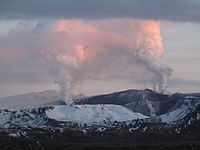
Volcanic activity may be activity from or by a volcano or activity from the sources of volcanoes.
On Iceland this year there is an increase in volcanic activity as shown in the photo on the right.
"Our research makes the connection between recent accelerated uplift and the accelerated melting of the Icelandic ice caps."[1]
"There is actually geological evidence that during the past deglaciation about 12,000 years ago, volcanic activity in some regions of Iceland increased thirtyfold. In fact, some estimate that this uplift could increase the frequency of volcanic eruptions such as the 2010 eruption of Eyjafjallajokull, which had negative consequences worldwide."[2]
Activity
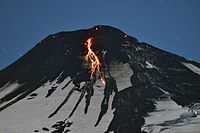
Def. "the quality or state of [...] causing change"[3][4] is called activity.
"The lava [from the Villarrica volcano on the right] traveled down the slopes of the 9,380-foot high volcano, melting snow along the way and creating mudflows."[5]
Volcanic
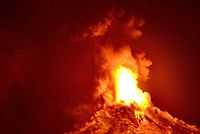
Def.
- of "or pertaining to a volcano or volcanoes",[6]
- produced "by a volcano, or, more generally, by igneous agencies",[6] or
- changed "or affected by the heat of a volcano"[6]
is called volcanic.
"This is one of the more spectacular volcanic eruptions the world has seen lately [imaged on the right]. Early in the morning on March 3, Villarrica in Chile erupted, sending ash and lava flying some 3,300 feet up into the atmosphere."[5]
"The eruption caused nearly 4,000 people to flee the surrounding areas, including from the nearby tourist town of Pucón, though the BBC reports that residents mostly left "calmly." After about 20 minutes, the volcano piped back down, and the nearby towns seemed okay."[5]
"Villarica is one of Chile's most active volcanoes and, according to the Smithsonian's Global Volcanic Program, is one of three tall stratovolcanoes in a chain that runs perpendicular to the Andes mountain range, believed to be caused by a fracture in the Earth's crust."[5]
Eruption clouds
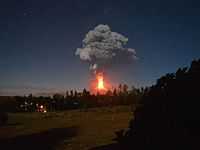
In the photo on the right, Villarrica volcano can be seen erupting clouds on March 3, 2015.
Lava fountains

On the right is "a close-up of the lava fountains" from the March 3, 2015, eruption of Villarrica volcano in Chile.[5]
"Villarica is one of Chile's most active volcanoes and, according to the Smithsonian's Global Volcanic Program, is one of three tall stratovolcanoes in a chain that runs perpendicular to the Andes mountain range, believed to be caused by a fracture in the Earth's crust."[5]
Lava lakes
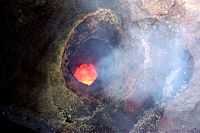
"Most of the time, though, the volcano is a popular destination for hikers, who climb the 9,380-foot high mountain during the summer months to peer at the lava lake in its crater."[5]
Lahars
"Because the volcano itself is covered by 15 square miles of glaciers, the lava that flows down the side and mixes with ice and snow to form lahars — a mudflow slurry that can move extremely quickly and destroy towns in their path. According to the Smithsonian, "lahars have damaged towns on Villarica's flanks." The BBC reports that more than 100 people are believed to have been killed by the volcano's mudflows in the past century."[5]
Lightning
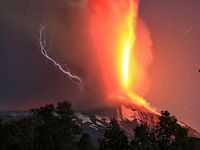
On the right is an image of the Villarrica volcano erupting near Pucon, Chile, March 3, 2015, with lightning.
Tufa
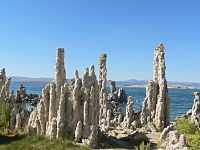
Def. "the calcareous deposit of lime found near hot springs"[7] is called tufa.
The image on the right shows Mono Lake's "South Tufa".
"Tufa towers in Mono Lake are calcium carbonate spires and knobs formed by interaction of freshwater springs and alkaline lake water. Tufa can reach heights of 30 ft. (9.1m). Mono Lake is located is Eastern Sierra Nevada and covers about 65 square miles. Throughout the lake's existence of over 1 million years, the steady evaporation of freshwater originally coming from Eastern Sierra streams has left the salts and minerals behind so that the lake is now about 2 1/2 times as salty and 80 times as alkaline as the ocean."[8]
Tuff
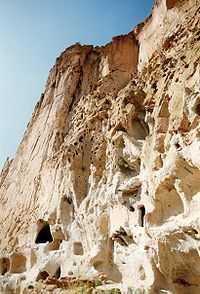
Def. a "light porous rock, now especially a rock composed of compacted volcanic ash varying in size from fine sand to coarse gravel"[9] is called tuff.
Research
Hypothesis:
- Every 10° of longitude has at least one form of volcanic activity.
Control groups

The findings demonstrate a statistically systematic change from the status quo or the control group.
“In the design of experiments, treatments [or special properties or characteristics] are applied to [or observed in] experimental units in the treatment group(s).[10] In comparative experiments, members of the complementary group, the control group, receive either no treatment or a standard treatment.[11]"[12]
Proof of concept
Def. a “short and/or incomplete realization of a certain method or idea to demonstrate its feasibility"[13] is called a proof of concept.
Def. evidence that demonstrates that a concept is possible is called proof of concept.
The proof-of-concept structure consists of
- background,
- procedures,
- findings, and
- interpretation.[14]
See also
- Sedimentary volcanoes
- Volcanic minerals
References
- ↑ Kathleen Compton (30 January 2015). "Melting Glaciers is Causing Iceland to Rise and May Increase Volcanic Activity". Iceland: Science World Report. Retrieved 2015-03-27.
- ↑ Catherine Griffin (30 January 2015). "Melting Glaciers is Causing Iceland to Rise and May Increase Volcanic Activity". Iceland: Science World Report. Retrieved 2015-03-27.
- ↑ "activity, In: Wiktionary". San Francisco, California: Wikimedia Foundation, Inc. 2 February 2015. Retrieved 2015-03-16.
- ↑ "active, In: Wiktionary". San Francisco, California: Wikimedia Foundation, Inc. 4 January 2015. Retrieved 2015-03-16.
- 1 2 3 4 5 6 7 8 Brad Plumer (4 March 2015). "Chile's recent volcanic eruption looked absolutely stunning — and terrifying". Villarrica, Chile: Vox. Retrieved 2015-03-27.
- 1 2 3 "volcanic, In: Wiktionary". San Francisco, California: Wikimedia Foundation, Inc. 13 February 2015. Retrieved 2015-03-16.
- ↑ "tufa, In: Wiktionary". San Francisco, California: Wikimedia Foundation, Inc. 4 February 2015. Retrieved 2015-03-16.
- ↑ Mila Zinkova (11 May 2007). "File:Mono lake tufa.JPG, In: Wikimedia Commons". San Francisco, California: Wikimedia Foundation, Inc. Retrieved 2015-03-16.
- ↑ "tuff, In: Wiktionary". San Francisco, California: Wikimedia Foundation, Inc. 18 February 2015. Retrieved 2015-03-17.
- ↑ Klaus Hinkelmann, Oscar Kempthorne (2008). Design and Analysis of Experiments, Volume I: Introduction to Experimental Design (2nd ed.). Wiley. ISBN 978-0-471-72756-9. http://books.google.com/?id=T3wWj2kVYZgC&printsec=frontcover.
- ↑ R. A. Bailey (2008). Design of comparative experiments. Cambridge University Press. ISBN 978-0-521-68357-9. http://www.cambridge.org/uk/catalogue/catalogue.asp?isbn=9780521683579.
- ↑ "Treatment and control groups, In: Wikipedia". San Francisco, California: Wikimedia Foundation, Inc. May 18, 2012. Retrieved 2012-05-31.
- ↑ "proof of concept, In: Wiktionary". San Francisco, California: Wikimedia Foundation, Inc. November 10, 2012. Retrieved 2013-01-13.
- ↑ Ginger Lehrman and Ian B Hogue, Sarah Palmer, Cheryl Jennings, Celsa A Spina, Ann Wiegand, Alan L Landay, Robert W Coombs, Douglas D Richman, John W Mellors, John M Coffin, Ronald J Bosch, David M Margolis (August 13, 2005). "Depletion of latent HIV-1 infection in vivo: a proof-of-concept study". Lancet 366 (9485): 549-55. doi:10.1016/S0140-6736(05)67098-5. http://www.ncbi.nlm.nih.gov/pmc/articles/PMC1894952/. Retrieved 2012-05-09.
External links
![]() This is a research project at http://en.wikiversity.org
This is a research project at http://en.wikiversity.org
| |
Development status: this resource is experimental in nature. |
| |
Educational level: this is a research resource. |
| |
Resource type: this resource is an article. |
| |
Resource type: this resource contains a lecture or lecture notes. |
| |
Subject classification: this is a Geology resource. |